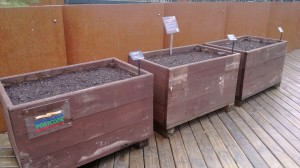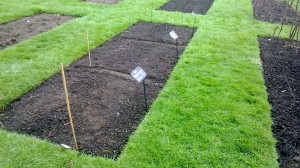Building on the success of the Really Wild Veg trials last year we will be doing further growing trials this year. Last year we grew beet, radish and cabbage varieties, including both modern F1 hybrid and heritage varieties, alongside their wild relatives to assess differences in yield, taste, nutritional content and pest/disease incidence. The trial with wild cabbage will be repeated, but this time with comparisons being made with a heritage kale and a modern F1 hybrid kale. Because wild cabbage does not form a head we have decided that a fairer comparison would be to use varieties of kale. Kale is just one of the many vegetables including broccoli, cauliflower and brussels sprouts that have all been derived from the wild cabbage. It is quite incredible that one wild species has given rise to such a variety of form under domestication.

The carrot trial on the decking at the John Hope Gateway Building just after sowing on 22nd April 2014.
The repeated cabbage trial will be joined by a new trial looking at carrots. The carrot is thought to have been domesticated in Afghanistan and has spread world wide to become an important root crop. Scotland has populations of the wild carrot and these are often found in coastal grasslands.
Thanks to the tastes of our resident badgers we cannot grow carrots in the Demonstration Garden and this trial is being conducted in planters on the decking of the John Hope Gateway.
Trials will take place at four gardens this year:
- The Demonstration Garden and decking area outside the John Hope Gateway Building at the Royal Botanic Garden Edinburgh
- Redall Walled Garden, Edinburgh
- Hermitage Vegetable Garden, Edinburgh
- Cruickshank Botanic Garden, Aberdeen
As we did last year we will be comparing the crop wild ancestor with a heritage variety and an F1 hybrid variety. The varieties being grown this year are:
- ‘Red Russian’ a heritage variety of kale said to have been brought from Siberia to Canada in 1885 by Russian traders
- ‘Reflex’ a modern F1 hybrid kale that has been given an RHS Award of Garden Merit
- ‘Long Red Surrey’ a heritage carrot that was introduced in 1834 and is also know by the name ‘Chertsey’
- ‘Fly Away’ a modern F1 hybrid carrot bred for resistance to carrot root fly

Cabbage trial sown on 29th April in the Demonstration Garden adjacent to the Queen Mother’s Memorial Garden.
The results of last year’s trials are not yet all available as the nutritional analysis at the Rowett Institute of Nutrition and Health is still ongoing. Some general trends that have emerged so far are that F1 hybrid varieties are often the most productive. This fits with expectations as the reason that hybrid varieties are created is that by crossing two different strains the phenomenon on ‘hybrid vigour’ is seen in the offspring and this produces larger and faster growing plants. The other interesting trend is that wild species have a stronger flavour compared to their domesticated cousins. In blind taste tests a clear majority of participants preferred the stronger flavour of the wild plants.
Keep following this blog for updates from the four gardens involved in the trials and for results as they emerge.
This work is possible thanks to support received from players of the People’s Postcode Lottery.


1 Comment
1 Pingback